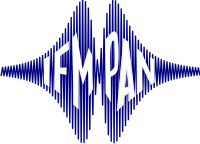Molecular self-assembly and charge transfer phenomena in ionic liquid organic gels: Investigation of molecular and electrophoretic dynamics
The most important achievements of the project are:
- Manufacturing of three types of thermally reversible ionic gels:
- TYPE I: ionic gels based on LMWG and hydrous electrolyte solutions (systems with the easiest way of chemical modification of used ions),
- TYPE II: ionic gels based on LMWG an anhydrous electrolyte solutions (systems characterized by enhanced thermal stability and wider temperature range of gel phase existence),
- TYPE III: ionic gels based on pure ionic liquids (systems that use a chemically stable and durable chemical compounds classified as so-called „green chemicals”).
- Identification of the molecular mechanisms responsible for gelation process in ionic gels being investigated in the project.
- Determination of the parameters and processes involved in gelation process leading to obtaining ionic gels with defined physical properties, such as: gel matrix microstructure, thermal stability, temperature range of the gel phase occurrence or optical appearance of the ionic gels (transparent or opaque gel phase).
- Determination of the gel matrix influence on the ionic transport properties in the gel phase.
- Determination of the ions influence on the self-assembly processes responsible for gelation.
- Identification of the intermolecular interactions between the liquid phase (electrolyte solution) and solid phase of the gel matrix characterized by slow dynamical processes.
- Proposition of possible molecular mechanism involved in the intermolecular interactions at the interphase confirmed by a theoretical model.
- Development of a new measurements method (Thermal Scanning Conductometry – TSC) for investigations of the thermal and conductive properties of ionic gels based on LMWG with high accuracy and sensitivity (detection of the phase transitions influence on the conductivity of sample). The method allows for the first time to conduct the measurements during rapid cooling of the hot sol state, what leads to gel creation, what allowed to study the influence of the cooling stage kinetics on the final properties of the ionic gels.
- Electrophoretic Nuclear Magnetic Resonance (eNMR) studies delivered groundbreaking results concerning the electrophoretic mobility and effective charge of investigated ions (cations and anions) in the ionogel phase. The obtained results shed new light on the observed EICE effect (Enhanced Ionic Conductivity Effect) and can contribute to development of new knowledge and theory of ions in solutions.
- Building of two new experimental sites: for measurements of thermal and conductive properties of ionic gels with TSC method and for viscosity measurements with tuning-fork method. Both stands introduce new types of experiments and methodology into studies of thermally reversible ionic gels and electrolyte solutions.
Project was supported by the National Science Centre from funds awarded through the decision No. DEC-2013/11/D/ST3/02694.



